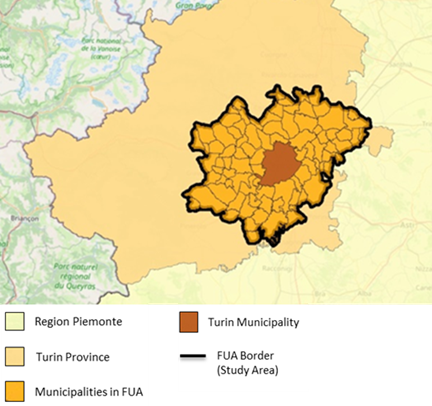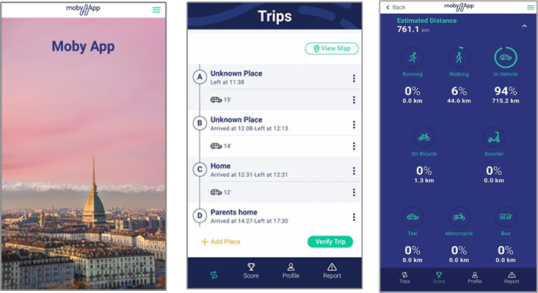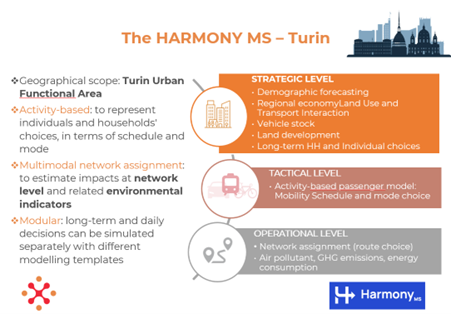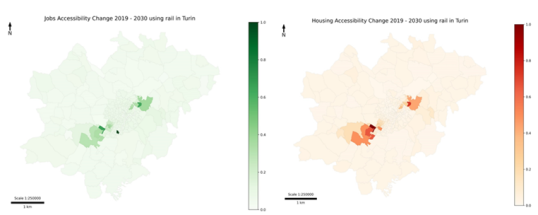- Topic
- Policy and research
- Urban mobility planning
- Country
- Italy
- Resource type
- Case study
First published 26 July 2023
HARMONY is a CIVITAS Horizon 2020 research project aimed at enabling metropolitan area authorities to lead a sustainable transition to a low-carbon, new mobility era. It aims to develop a new generation of multimodal transport planning tools, harmonised at the European level, that model in an integrated way the dynamics of the transport sector and of spatial planning. Its spatial and multimodal transport planning tools are designed to support the evaluation of Sustainable Urban Mobility Plans (SUMPs) through the simulation of an integrated set of measures.
The project involved six metropolitan areas: Turin (IT), Rotterdam (NL), Oxfordshire (UK), Athens and Trikala (GR), and Upper Silesian-Zaglebie (PL).
The Turin case-study focused on modelling the territorial impact of new public transport infrastructure, and also exploring the topics of remote working and urban vehicle access regulation. As part of the project, the analysis of transport behaviour and personal attitudes towards changes in travel patterns was performed with a survey using a smartphone application.
Context
Turin is an Italian metropolitan city located in the North-West of Italy, in the Piedmont region. Thanks to its location close to France and its proximity to Milan and Genoa, Turin plays a crucial role as a strategic crossing point for the transfer of people and goods between Italy and France.
The Metropolitan City of Turin’s SUMP was approved in July 2022 and aimed to foster accessibility, improve liveability and road safety, and achieve environmental and energy sustainability of the transport sector with the support of technological innovation.
Within this context, the Turin municipality pursues the goal of rebalancing the demand for collective and individual transport to reduce congestion and improve accessibility to the city centre and various urban functions. Pursuing this strategy implies an efficient mobility policy that pushes collective transport use through the implementation of large infrastructure projects (such as the underground and the metropolitan railway service) and the development of new intelligent transport system (ITS) technologies. In addition, the aim is, on the one hand, to improve the efficient use of these services and, on the other hand, develop new shared services.
Within the framework of the HARMONY project, considering the overall vision described above, several modelling scenarios were tested. The scope of the study area of the model was Turin’s Functional Urban Area (FUA), which comprises the City of Turin and another 87 municipalities (see Figure 1) that had a total population of about 1.7 million in 2019.
Figure 1: Turin Functional Urban Area (FUA)
In action
In line with the recently approved SUMP of the Turin Metropolitan Area, the modelling application in HARMONY aimed to study urban mobility planning with a vision towards 2030, investigating the territorial impact of new public transport infrastructure, as well as of remote working and urban vehicle access regulation.
The Turin Municipality and Turin Urban Lab were partners of the project and were involved with the creation and development of co-creation labs, together with residents and stakeholders, to analyse mobility in the wider context of the city’s emerging trends and vision for the future. Furthermore, primary data was collected to understand the level of social acceptance of the new mobility services and technologies.
With the goal of exploring mobility habits in the urban area and of supporting the modelling application, a passenger survey was conducted using a free smartphone application, the Moby App (see Figure 2). To take part in the survey, participants had to download the app that tracked their trips and activities, including their time schedule, travel path and modal choice. Some complementary questionnaires were included in the app to collect additional information on transport behaviour. Personal attitudes towards changes in travel patterns, and towards autonomous vehicles, are examples of the useful information collected.
Figure 2: Turin survey - MOBYapp
With the support of a survey company, IPSOS, to recruit participants, a representative panel of residents (defined by macro-zone, gender, age, employment, and car ownership) was selected to participate in the survey. A total of 584 users aged between 18 to 65 years old downloaded the application, tracked their trips over a period of between four and seven days, and completed the complementary questionnaires. To further complement the data collected, an additional survey was performed on a voluntary basis in Turin in March 2022 (see Figure 3).
Figure 3: Turin survey timeline
Analysis of the data on passengers’ mobility habits supported the modelling applications. The HARMONY Model Suite was used for the simulations, involving strategic-tactical and operational models. These models interacted with each other, exchanging data as shown in Figure 4 below.
Figure 4: Strategic-tactical and operational Model Suite for Turin
A first use case was designed to consider selected land use developments and the new public transport infrastructure that was planned to be in place by 2030 in the SUMP reference scenario. Some of the transport infrastructure projects aimed to improve public transport services at the urban and inter-urban level (such as a new metro and tram lines, as well as the improvement of the metropolitan railway network), and other land use development projects that related to the university, health and public administration office were included for their relevance at the metropolitan scale.
Additionally, the impacts of the changes in the mobility patterns of individuals, as a result of remote working and revised activity schedules due to covid-19, were tested.
Finally, the focus of one use case was the introduction of urban vehicle access regulations (UVARs), namely the revision of the existing Limited Traffic Zone (LTZ) in Turin’s city centre, the implementation of traffic calming zones in Turin and in the first belt municipalities and the implementation of Low Emission Zones (LEZs) in Turin and in several surrounding municipalities. It was assumed that by 2030, the latter measure would only allow the circulation of petrol and diesel vehicles in Turin with a minimum standard of EURO6, as well as hybrid and electric vehicles.
Results
Stakeholders and residents’ engagement in co-creation lab activities
In November 2022, a workshop on the survey results and on HARMONY Model Suite (MS) application took place in Turin, in which institutions, experts and professionals participated. The objectives and expected results of the project were presented, including an overview of the modelling applications developed for the Turin metropolitan area, the passenger survey conducted with the smartphone application, and a demonstration of the HARMONY MS user interface for simulating scenarios. The workshop was part of the project’s engagement process, with the objective to present the activities carried out and discuss and explore barriers, strengths, opportunities and the desirability of the modelling tool that was developed.
During the project, several co-creation and stakeholders’ engagement activities were organised, which included interviews, focus groups and workshops, which aimed to analyse mobility in Turin in the wider context of the city’s emerging trends and vision for the future. The purpose of the participatory process was also to find synergies with other local projects, discuss the application of the modelling tools, generally and in relation to the SUMP, and share knowledge, expertise and lessons learned on emerging mobility topics to support the process towards decarbonisation.
Collection of primary data on transport behaviour (survey through the Moby App)
The modal split obtained from the passenger survey showed that the car is the most used transport mode (49%) in the FUA. Walking trips are also significant (33%) while public transport trips only accounted for 16%. Bikes are used for less than 3% of trips. In addition, the analysis of the modal split by employment status provided some hints on the different mobility habits. As shown in Figure 5, students (above 18 years) use a car less than the average. Instead, they move much more by public transport, bicycle or on foot. Employed and retired people show a similar modal split, with a large use of the car (more than 50%) and have a below-average share of trips performed by public transport. Unemployed people walk and use public transport comparatively more than the average.
Figure 5: Survey results: Modal share in the Functional Urban Area of Turin
Another interesting finding from the survey was the duration of trips recorded by the Moby App. About half of the trips lasted less than 15 minutes, whereas 35% of all trips lasted 10 minutes or less, and on average, travel time per trip was 23.5 minutes. About 20% of trips last more than 30 minutes (see Figure 6).
Figure 6: Survey results: Trip duration in the Functional Urban Area of Turin
The same analysis was performed on the duration of car trips. The share of short trips (up to 10 minutes) was slightly lower (24%) and the share of trips over 30 minutes was larger (30%). Furthermore, it is remarkable that almost one third of all registered car trips lasted less than 15 minutes. Therefore, the survey demonstrated that the car is widely used even for very short distances on which active modes could be very competitive. In this sense, there is room to support tailored policies that promote active modes and move towards a more sustainable urban mobility.
Application of HARMONY MS to support the evaluation of transport policies related to medium- and long-term planning
The HARMONY MS was used to simulate specific strategies in the Turin FUA by selecting measures from scenarios designed for the metropolitan SUMP. The impacts of land use developments and new public transport infrastructure planned by 2030 in terms of the accessibility to jobs and housing are presented in Figure 7 below, with notable changes in the Lingotto area, and along the north-east to south-west axis of the new metro line.
Figure 7: HARMONY MS results: jobs and housing accessibility change by rail in Turin (2019-2030)
In terms of the modal split, the scenario led to an increase in the share of public transport by 1% in the municipality of Turin and by 1.3% in the rest of the FUA by 2030 compared to 2019 (see Figure 8).
Figure 8: HARMONY MS results: modal split in Turin and the rest of the FUA (2019-2030)
The scenario that related to the UVAR measures led to strong increases in the share of public transport and a significant reduction in private car trips: specifically, a reduction of 27% in Turin and 20% in the rest of the FUA (see Figure 9).
Figure 9: HARMONY MS results: impact on private car trips due to UVAR measures
Looking at the impacts on CO2 emissions, the scenario related to land use and public transport infrastructure showed a reduction of about 20% with respect to the base year 2019, mainly due to the projected composition of the car fleet where the number of petrol and diesel vehicles decreases. The remote working scenario showed a 30% reduction of emissions with respect to the base year due to a reduction in number of trips. Finally, in the scenario related to UVARs a large reduction of about 40% was estimated for Turin, while in the rest of the FUA it was about 17% (see Figure 10).
Figure 10: HARMONY MS results: CO2 emissions in Turin (2019-2030)
Challenges, opportunities and transferability
The case-study presents an example of how to use transport modelling to analyse and support transport and land use planning.
The integrated use of the Moby App and HARMONY MS demonstrated some significant advantages over traditional ways of integrating travel and daily activity data with model systems, but also some barriers and technical difficulties. The survey process is far from automated, and apart from regular data cleaning algorithms, specific and human-driven data correction algorithms need to be put in place to remove GPS errors and duplicates in the database and improve mode and activity prediction. The effort of the user is imperative to acquiring useful and cleaner data, and it is important to stress the effect of incentives or rewards in the process of data collection and sample recruitment in order to motivate survey respondents to verify their trips and activities. Data elaboration for use within the modelling platform also needs additional effort.
The modular and flexible deployment of the HARMONY MS proved to be useful for the use cases investigated in Turin, using several modelling components in an integrated way and provided interesting results through the analysis of key performance indicators, ranging from transport to socio-economic and environmental topics.
In Depth
Turin’s case-study is on HARMONY’s website: https://harmony-h2020.eu/turin/
Results of the passenger mobility survey in Turin:
https://harmony-h2020.eu/wp-content/uploads/2022/09/Results.pdf
For more specific, relevant information about the transport modelling application in Turin, please contact:
- Francesca Fermi, TRT Trasporti e Territorio: fermi
 trt [dot] it (fermi[at]trt[dot]it)
trt [dot] it (fermi[at]trt[dot]it) - Athina Tsirimpa, Moby App a [dot] tsirimpa
 mobyx [dot] co (a[dot]tsirimpa[at]mobyx[dot]co)
mobyx [dot] co (a[dot]tsirimpa[at]mobyx[dot]co) - Giuseppe Chiantera, Municipality of Turin: giuseppe [dot] chiantera
 comune [dot] torino [dot] it (giuseppe[dot]chiantera[at]comune[dot]torino[dot]it)
comune [dot] torino [dot] it (giuseppe[dot]chiantera[at]comune[dot]torino[dot]it)
Photo Credits:
HARMONY project and Moby App
© Zdenek Matyas Photography / Shutterstock.com - no permission to re-use image(s) without separate licence from Shutterstock.











